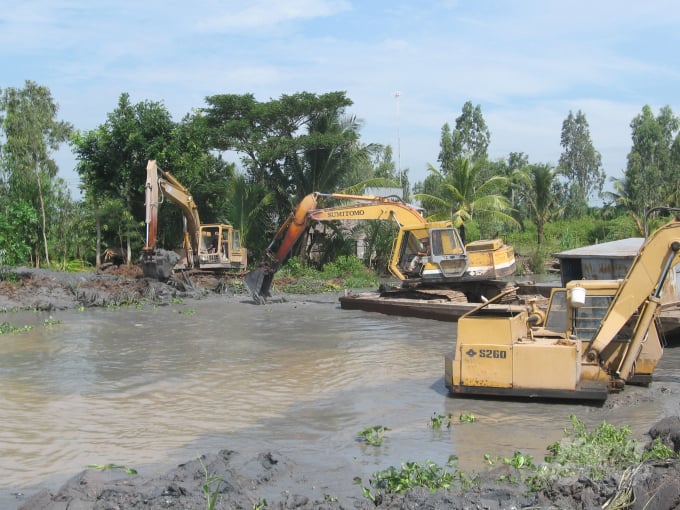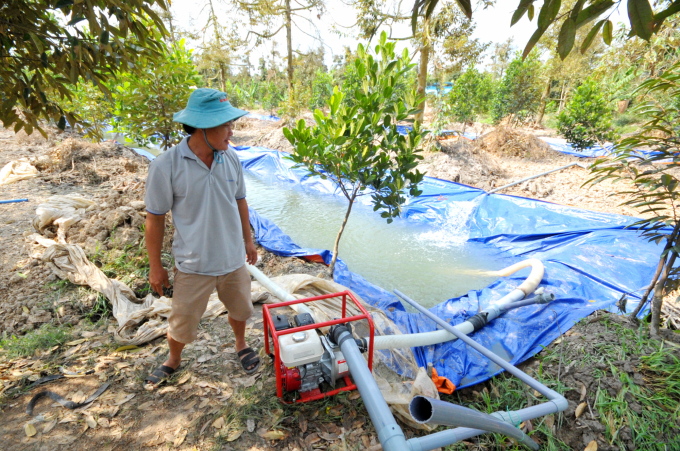November 24, 2025 | 15:05 GMT +7
November 24, 2025 | 15:05 GMT +7
Hotline: 0913.378.918
November 24, 2025 | 15:05 GMT +7
Hotline: 0913.378.918
In the past few days, in the southern province of Soc Trang, particularly along the coastal area of Vinh Chau and the estuaries of Hau and My Thanh rivers, the strong easterly wind combined with the full moon tide in the middle of lunar January have caused saltwater to enter the estuaries and penetrate deep into the inland waters.

Soc Trang province has implemented many irrigation and canal dredging project. Photo: TX.
Pham Tan Dao, Head of the Sub-Department of Irrigation, Chief of the Office of the Commanding Committee for Disaster Prevention and Search and Rescue of Soc Trang Province, said that before the Lunar New Year, the dry season reached to peak, resulting in the increase of salinity. Therefore, localities with canals and canals adjacent to estuaries, along large rivers and key dam culverts have closed sluice gates.
At present, salinity intrusion is expanding from Hau River, passing Dai Ngai to Ke Sach town, Ke Sach district with the salinity of up to 4-5 ‰.
Vu Ba Quan, Head of the Department of Agriculture and Rural Development of Ke Sach district said that saltwater had arrived in An Lac Tay commune. At Vam Rach Vop, the salinity is from 3 to 3.2 ‰ and is likely to increase to 4‰ . Currently, the local area in five communes with orchards is still safe. But if the salinity is too high, the crops in the freshwater area will be affected.
Therefore, local agricultural officials update the salinity information and advise farmers to close culverts, store fresh water for the orchards, Quan said.
Soc Trang province is considered an important area with a coastline of 70 km long.
According to experience, through the fierce dry season in the years 2015 - 2016 and 2019 - 2020, the peak salinity caused a lot of damage to agricultural production. The province changed production structure and crop season schedule. It also paid special attention to irrigation solutions to prevent salinity, store fresh water and protect crops in the dry season.
According to the Soc Trang Irrigation Sub-Department, thanks to the early planting schedule change, so far, most of the more than 40,000 ha of2021-2022 winter-spring rice around the Long Phu - Tiep Nhut irrigation system have been harvested.
Currently, the amount of fresh water stored in the canal system could ensure rice-carrying boats and harvester-carrying boats to move until middle of next month.

Farmers in the Mekong Delta provinces in general and Soc Trang in particular are actively and proactively storing fresh water to cope with the risk of drought and salinity in the coming time. Photo: VAN.
At present, the irrigation system in Soc Trang province is divided into seven project areas including Ke Sach project area, Song Hau island area, Long Phu - Tiep Nhut project area, Ba Rinh - Ta Liem project area, and Ba Rinh - Ta Liem project area, Phung Hiep Highway project and Thanh My project area.
In the past year, many projects drought and salinity prevention in the province such as Long Phu Tiep Nhut project area, Ba Rinh - Ta Liem project area were promptly completed and put into operation, ensuring service for agricultural production in the province. Particularly, the freshwater pumping station of Ba Xam culvert is under construction and will be completed in about a month, ensuring an additional supply of freshwater to meet production needs in the dry season. Meanwhile, the 10-sluice sluice system invested and under construction by the Ministry of Agriculture and Rural Development, expected to be completed by 2025, will protect the 40,000-hectare orchard in Ke Sach district.
Recently, Soc Trang province has proposed the Dai Ngai Lock project, which, if built, will ensure 80 per cent of fresh water for agricultural production in the province. The remaining 20 per cent belongs to some areas such as An Thanh Nam in Cu Lao Dung district and Vinh Chau coastal area, which are converting to aquaculture growing areas.
From the beginning of February 2022, according to the forecast of the Southern Institute of Irrigation Science, salinity may penetrate 50 - 65 km into the field and may affect production in both saltwater and freshwater areas. Therefore, the units managing and operating the sluices in the Mekong Delta need to regularly monitor the changes in salinity at stations in the area to have an appropriate operation plan.
Translated by Hien Anh

(VAN) The recent torrential downpours and unprecedented flooding in the Southern Central Coast are a highly unusual meteorological and hydrological event.

(VAN) The Southern Central Coast and Central Highlands regions have suffered massive agricultural losses, with over 80,000 hectares of rice and crops, alongside millions of livestock, being swept away, causing severe damage to farmer livelihoods.

(VAN) Trieu Son commune deploys a 'virtual assistant' to help residents complete administrative procedures.

(VAN) Applying green technology in rural water supply and sanitation helps improve resource efficiency, protect the environment, and enhance community living standards.

(VAN) Developing biosecure livestock production is the key that helps Tuyen Quang form linked chains in livestock production and build its brand in the market.

(VAN) During his bilateral activities in South Africa, Prime Minister Pham Minh Chinh welcomed Vice President of the South African Chamber of Commerce and Industry Neil Pollock.

(VAN) Prof. Dr. Hoang Van Cuong, National Assembly Deputy of the 14th and 15th terms, shares recent pioneering policy decisions.